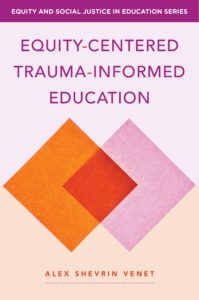Trauma and Teaching: Boundaries and Bridges
By Alex Shevrin Venet

I was completely caught off guard when my school administrator called me into a meeting to update on one of my students, who I’ll call Jade.
My administrator let me know that Jade had experienced a significant traumatic event a few weeks before and gave me some advice about how to support her in class.
My heart hurt for Jade, but I also had a nagging question: why didn’t my student tell me? Jade and I had a close relationship, and she often shared details about her life with me, from funny stories about her dog to everyday frustrations with family or friends.
I’ll admit I felt a little hurt that Jade hadn’t come to me for help – I knew I could have supported her.
Teacher-student boundaries
This was just one of many school experiences through which I came to learn the importance – and messiness – of boundaries when it comes to trauma-informed education. In a trauma-informed school, relationships are key. But what kind of relationships?
As schools set out to become trauma-informed or implement social-emotional learning, some teachers may feel concerned that their role is becoming fuzzy. “Am I supposed to a therapist? Or a social worker? That’s not my job, right?”
We know it’s important to acknowledge students’ emotions and be there for them during hard times, but this can get sticky pretty fast. Should we strive to be the ones that our students turn to? Or should we shut down conversations when we fear they could be getting too personal?
There are no easy answers to these questions, but there are key understandings about equity and trauma we can use to navigate them. In my book Equity-Centered Trauma-Informed Education, I affirm that teachers are indeed not supposed to be therapists, and we shouldn’t try to be. When we are clear about our role and our boundaries, we create the conditions for healthy relationships with our students.
Finding the “messy middle”
In building relationships with students, we have to consider how much to share of ourselves and how much of our students’ personal and emotional lives to engage with. Teachers can sometimes fall to either end of a boundaries spectrum, neither of which is particularly healthy.
On one end we act as “the walled fortress,” not letting students in or pieces of ourselves out. “Walled fortress” teachers might say things like, “Emotions aren’t my job” or “I’m only here to teach.” It’s okay to be a private person or to not be touchy-feely. At the same time, as educators we have to recognize that emotions are a core part of teaching.

At the other end of the boundaries spectrum, we find teachers who perhaps become a little too enmeshed in their students’ personal lives. These teachers, usually meaning well, may dig deep in conversations about students’ experiences of hardship or trauma.
Sometimes this looks like being a “trauma detective,” where we let our own curiosity about a student’s story, or our unexamined savior mentality, blur our role. If we aren’t careful, we may end up out of our depth.
This is where I ended up with Jade, when I realized we had gotten so close that I had an unspoken expectation that she should turn to me for support with an incredibly complicated traumatic situation, even though her needs were actually much better served by going to our school director or her school social worker.
Children thrive when they are supported by a network of caring adults, and if we attempt to be a teacher, counselor, confidante, and friend, we may be denying students the opportunity to build that network.
There is no single approach to boundaries that will work for everyone, but ideally we want to move away from either end of the boundaries spectrum toward the “messy middle.” It’s messy because boundaries require reflection, cultivation and care. Yet so much is possible when we invest in this work.
To begin finding our way through the messy middle, we need to more deeply understand why boundaries matter.
Equity, trauma, and boundaries
Equity-centered trauma-informed education is a new approach that I outline in my book of the same name. It recognizes that working toward equity and creating trauma-informed schools are inextricably intertwined. Deeply considering equity and trauma informs how we see boundaries.
For trauma-affected students, there can be additional layers of complexity to boundaries. Some child trauma is caused by adults transgressing boundaries, using coercion, and/or threatening children into keeping secrets. Children may lose trust in institutions like school and keep adults at a distance to keep themselves safe.

As we seek to build equitable school environments, boundaries deserve close attention. Students and their caregivers and families have different experiences, cultural norms and values connected to boundaries and the student/teacher relationship. We need to work to understand these considerations in partnership with our students and communities.
We also need to recognize that strong personal boundaries may be a form of self-protection for students who have been marginalized or traumatized at school. Teachers are not automatically safe people, and it’s not a given that schools are safe spaces.
When we begin to build relationships with our students and their caregivers and families, we must be respectful of the boundaries they set with us – just as we hope they will be with the boundaries we set.
Becoming a bridge-builder
With all of this complexity, how do we navigate relationship-building with our students in an equity-centered trauma-informed way? One of my key considerations for teachers: become a bridge-builder.
Bridge-building is a way of being student-centered as we form relationships. As I write in my book, “there is a common saying that just one caring adult can change the trajectory of the life of a child … As teachers, however, we shouldn’t take this to mean that we are the only caring adult in a student’s life.”
We need to examine any deficit beliefs we may hold about any perceived lack in students’ families and communities, and instead seek to build up a student’s network rather than becoming the sole point of support.
One way to build this network is through incorporating more adult connections into the curriculum. Bring in other adults from the school and the community to be authentic audiences for student work, or partner with community members and organizations for hands-on projects. Ask yourself: at the end of this unit, project, or term, how can I ensure my student is more connected to caring adults and peers than they were before?
Another key role is being a bridge to other supportive resources. When students bring up challenges that feel beyond your scope as a teacher, you have an opportunity to reinforce the message that it’s okay to ask for help. We can compassionately connect students to mental health resources within schools or in the community by making introductions and being a guide. For instance, there can be stigma around seeing the school counselor. Can we help with that?

Being a bridge-builder helps us shake loose any remnants of a savior mentality because it reminds us that we are just one adult in a much larger network around a student. Being real with myself, I wanted Jade to come to me first because it somehow would have affirmed my importance. That’s not a sustainable or healthy attitude, and it’s one I’m glad to say I’ve left behind.
As developing adolescents, our students are still figuring out which interests to cultivate, which strengths to proudly own. We can help them do this by honoring their full humanity and self-determination, not through positioning ourselves as their heroes or saviors. If we see our students in their full humanity, we recognize that they bring all of themselves to school, emotions and all, and we can find ways to meet them with flexibility and care.
When I reflected on what Jade actually needed, it wasn’t for her English teacher to hear all the details of her trauma. She needed support and access to resources, and our school director was much better positioned to help her with that than I was. She benefited from our school’s focus on bridge-building and the knowledge that she had others to go to besides just one teacher.
Healing by teaching
Sometimes the most healing thing a teacher can provide for students is teaching. Jade set her own boundary with me by keeping her trauma story to herself. That allowed us to spend our time in class focusing on what she actually needed from me: my support with writing and creative expression. By sticking to my role, respecting boundaries, and continuing to build bridges, I was able to be one point in that supportive web for Jade.
Navigating the “messy middle” of the boundaries spectrum allows us to create space for our students to grow as learners, and to hold this space sustainably. We fill our emotional wells through the authentic relationships we build with students, yet don’t become so enmeshed that we burn out.
Identifying and maintaining these healthy boundaries at school requires reflection and trusted colleagues to consult with. In my book I offer reflection questions and more considerations on boundaries and relationship-building. With time, attention and intention, our equity-centered trauma-informed relationships can flourish.





































